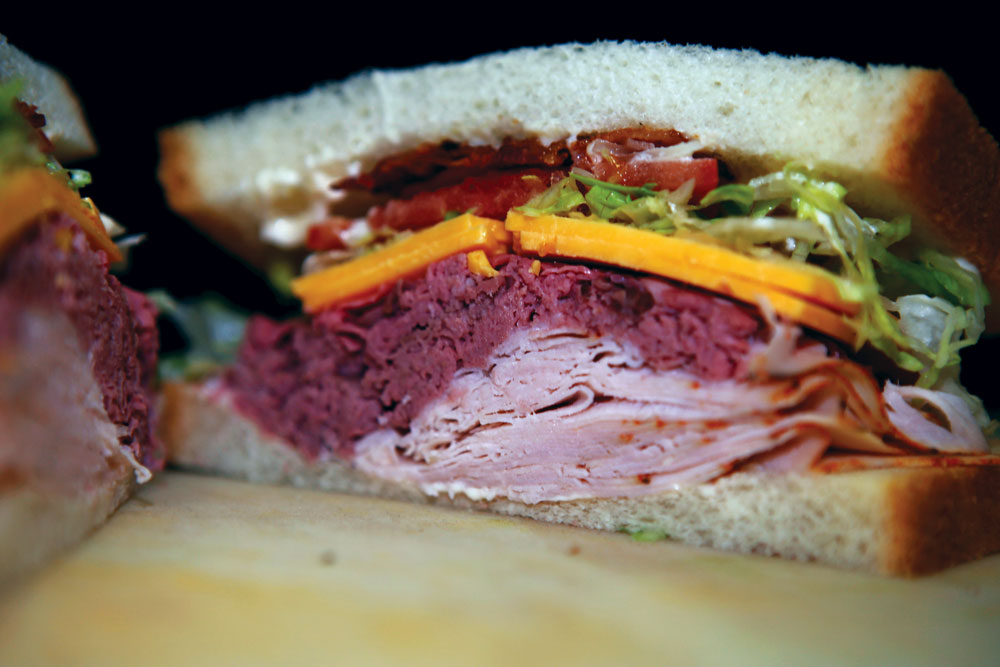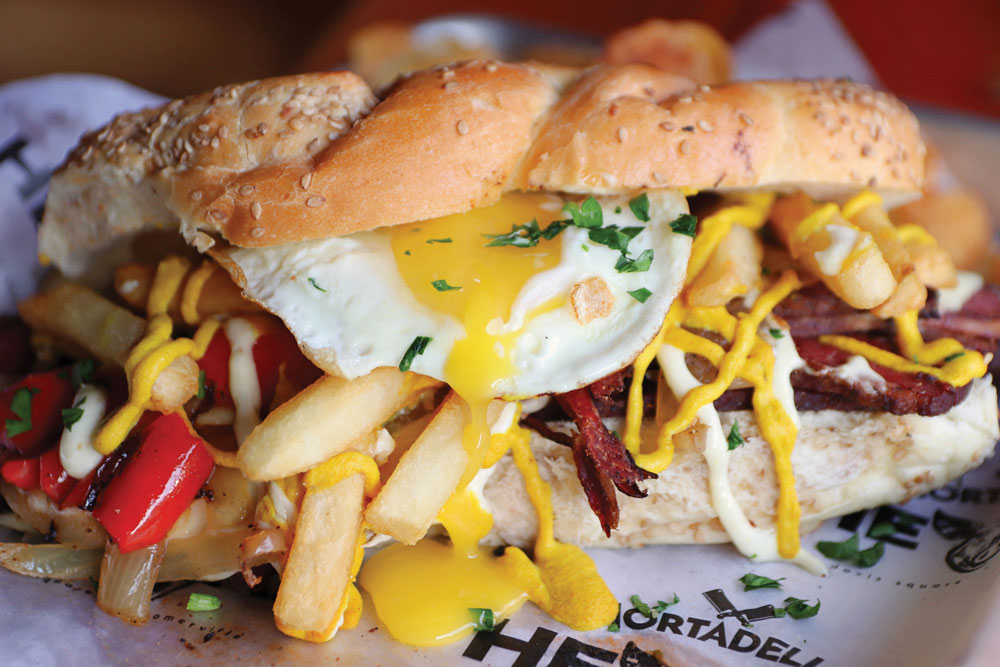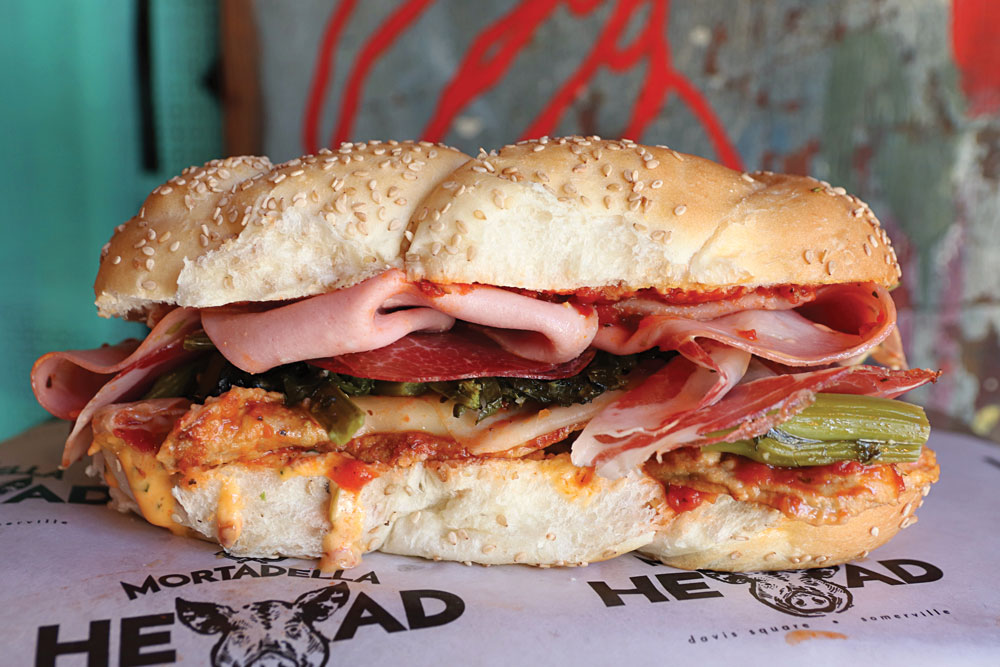Deli sandwiches aren’t a terribly different animal than pizza; they both rely on a bread base and can be topped or filled with essentially any ingredients. But, thanks to their different formats, sandwiches can exponentially diversify a menu. They give customers more choice, generally take less time to serve than pizza, and allow for eating on the go to fit today’s busy lifestyles.
“Almost five years into our business, we wouldn’t be at the point we are today if we didn’t do that deli-style menu,” asserts Anthony DeMarco, co-owner of DeMo’s Pizzeria & Deli in Raleigh, North Carolina. “It broadens our horizons—the best decision we’ve ever made.” Want to make the deli business a significant slice of your profits? Learn some success secrets from these two flourishing sandwich slingers.
 |
|
Each sandwich at DeMo’s Pizzeria & Deli is piled with 5 ounces of meat and fresh, farmers market-sourced veggies. |
DeMo’s Pizzeria & Deli | Raleigh, NC
Before owners DeMarco and Clay Adams opened their downtown Raleigh hotspot, they honed their chops at a 4,000-square-foot restaurant and nightclub in the suburbs for nearly three years. Given the opportunity to infiltrate an up-and-coming business and nightlife district, they leaped at the chance—but knew they’d have to cash in on lunch crowds and catering for local offices. “People aren’t going to eat pizza all the time; it’s not necessarily an everyday food,” DeMarco explains. “So we wanted to have different options with a pizza and deli operation.”
Winning Ways
- Think local and seasonal. DeMo’s sandwiches feature bread made fresh daily, as well as seasonal veggies, both purchased from the local farmers market.
- Partner with a strong brand. “We use Boar’s Head, which has a good reputation to match our other high-quality products, and the reviews we’ve been getting back it up,” DeMarco says. “We use their meats, cheeses, even pepperoni (on both sandwiches and pizzas).” Of course, if you stock a well-known name, make sure it’s clearly conveyed on your menu, website and marketing materials.
- Add some DIY touches. Made-to-order egg salad, as well as housemade chicken and tuna salads and coleslaw, have proved a hit with guests. DeMo’s often runs through 10 to 20 pounds of chicken and tuna salad daily.
- Cater to special diets. As lighter options, DeMo’s offers spinach and gluten-free wraps. Vegan cheese also makes the menu. “Nowadays, customers need those choices,” DeMarco says. “With so many people coming in for our sandwiches, we have to offer something for everyone.”
- Keep it simple. In a much smaller space than their previous location (1,400 square feet), the DeMo’s owners streamlined the menu to predominantly pizza, sandwiches and salads. The sandwich menu itself is fairly straightforward: eight specialty cold sandwiches, eight hot sandwiches, and a create-your-own option, for which customers choose their bread, meat, cheese, toppings, spreads, and add-ons like avocado or bacon.
- Show your stuff. Though adding deli operations needn’t require much additional equipment, DeMo’s takes its sandwiches seriously with a 12’ deli case displaying meats and other merch. “If you’re just trying to add sandwiches, you don’t have to be that elaborate,” DeMarco notes. “But ‘deli’ is in our name, and we charge a premium price, so it’s important for us to do more.”
- Angle for catering orders. In a booming business district, party trays and boxed lunches are big business for DeMo’s. DeMarco often promotes the option by taking trays to local corporations so they can try the goods, gratis. “Sandwiches are so easy to do for catering: throw together 30 to 50 subs, cut them in quarters, make them look nice, and send them out on a platter,” DeMarco says. “It’s easy money and really helps the bottom line.”
- Stand out through quality. Fresh ingredients are a must, but customers also notice when operators aren’t skating by on the bare minimum. For example, while some competitors use frozen meat for cheesesteaks, DeMo’s goes through 75 pounds of Black Angus top round beef each week on these sandwiches alone—cooking and roasting to medium-rare in-house before slicing and portioning into 5-ounce heaps for each sandwich.
- Mind your speed. When locals are swarming during the lunch rush, avoid lengthy lines by optimizing your kitchen design and operations for speedy sandwich assembly. “We do a fast sandwich,” DeMarco says. “We’re heavy on quality but make sure we crank ’em out quick!”
Mortadella Head | Somerville, MA
In the Boston area, pizza-and-sub shops are commonplace; it’s a combination that Chuck Sillari, co-owner of Mortadella Head with Sebastian Fricia, grew up with. But, while overseeing his 10-year-old, four-location Boston Burger Company, Sillari realized that most of these outposts were pretty uninspired—all serving up roughly the same menu items in a dreary, old-school setting. He envisioned something different to cater to the area’s influx of trend-fueled hipsters. “We wanted to take that old-school pizza/sub shop and reinvent it with a fun menu and better ingredients,” Sillari explains. “We’ve been open only three months, but so far, it’s been working really well!”
 |
|
In lieu of traditional advertising, mouthwatering “food porn” shots entice customers via Mortadella Head’s Facebook and Instagram pages. |
Winning Ways
- Try creative combos. Sillari credits much of his success to a menu that boasts unique specialty sandwiches, often with memorable, quirky names. The Mortadella Head combines a chicken cutlet, fried eggplant, roasted red peppers, mortadella, provolone, ricotta and vodka sauce. The Plymouth RockSTAR serves up Thanksgiving dinner in sandwich form, with roasted turkey, fried stuffing, American cheese, cranberry sauce, gravy and garlic aioli. And The Pig & Fig melds sweet and salty with prosciutto, poached pear, Gorgonzola, fig jam, mixed greens, house vinaigrette and a balsamic glaze.
- Strut your sides. Mortadella Head adds value in the form of included sides—and they ain’t your typical bonus bag of big-brand potato chips. Instead, each sandwich comes with housemade chips (tossed in Pecorino-Romano, rosemary, garlic butter, salt and pepper) and a choice of the pizzeria’s own giardiniera or pasta fagioli soup. For those who crave French fries, there’s an entire menu subset of gourmet options at a premium price: think Rhode Rage Fries, topped with fried calamari, banana pepper rings, garlic butter and lemon aioli, and Shepard’s Pie Fries, with ground beef, shredded carrots, sautéed onions, gravy and cheddar.
- Cross-utilize ingredients. With two types on offer—traditional round and Roman-style rectangular pies—Sillari can use many of his sandwich ingredients on pizzas, too. “For example, we have a pizza right now with grilled steak, peppers and onions, like a Philly cheesesteak,” he says. “We can cross-utilize so many things on our fries, sandwiches and pizzas: meats like mortadella, capicola and salami; vegetables like arugula and potatoes; and add-ons like rosemary and garlic cream sauce.”
- Encourage social media salivation. Sillari ditches traditional advertising and focuses strictly on social media to spread the word about his sandwiches and other menu items. Mouthwatering shots of Mortadella Head creations fill his restaurant’s Instagram and Facebook pages, accompanied by local-leaning hashtags like #bostoneats, #somerville and #davissquare, as well as general ones such as #foodie, #foodporn and #cheatmeal. “We have a lot of college students here, so we search to find what hashtags we know will work for that demographic,” Sillari explains. “We’ll even direct-message people on social media and say, ‘Come in Friday night to try this!’”
- Lighten up with LTOs. Limited-time sandwiches, often a result of sudden inspiration that leads to kitchen experimentation, are a regular feature at Mortadella Head. Recently, an off-the-cuff trial was so popular it made the permanent menu: the Porco Dio!, with porchetta, broccoli rabe, caramelized onions, provolone and Calabrian chili mayo. “There are no set rules, so we have a lot of fun with it,” Sillari says. “As we grow, we’ll probably get more systematized, like having a sandwich of the month. The sky’s the limit!”
Tracy Morin is PMQ’s senior copy editor.













